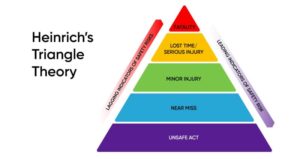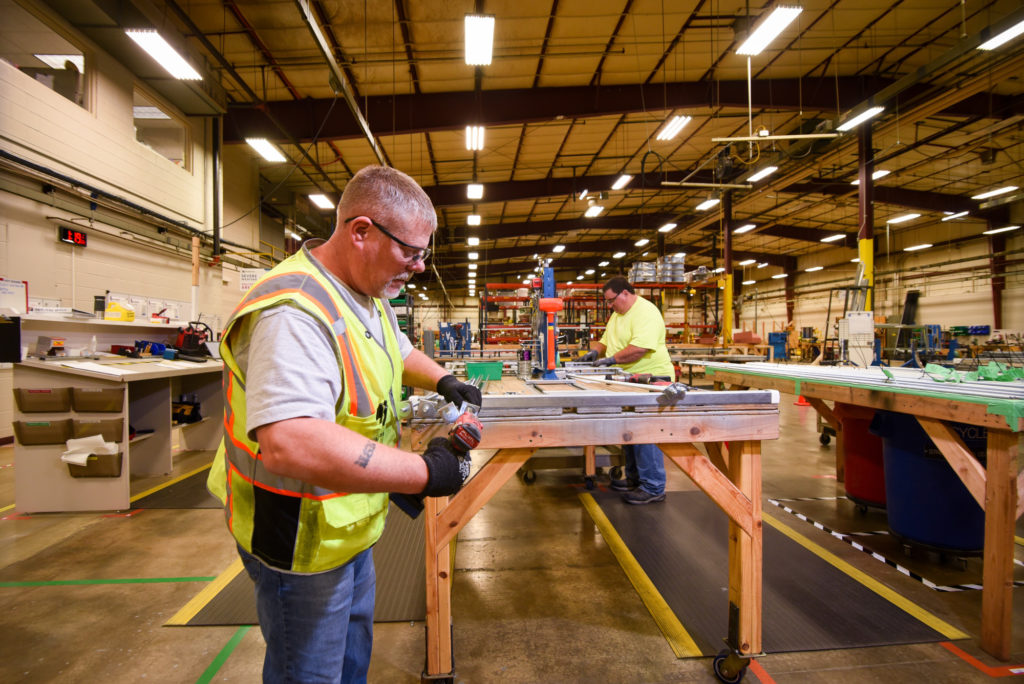August 17, 2022 Joseph Bolle
Using the Accident Triangle to Grow Your Safety Culture
The Accident Triangle is a theory of industrial accident prevention and shows the relationship between serious accidents, minor accidents, near misses and unsafe acts. It was initially developed by Herbert William Heinrich in 1931 and then furthered by Frank E. Bird in the late 1960s. The triangle was developed after analyzing nearly 2 million accident reports and confirmed in several corresponding studies. Simply put, it illustrates that the more unsafe acts we have, the more likely we are to have a serious incident over time.
 What are these unsafe acts and how can we reduce them? An unsafe act is anything that, if unaddressed, could lead to an accident. Failing to wear a seatbelt, forgetting to don appropriate PPE for a task, failure to follow a walking path near a forklift aisle or not setting up a hot work zone for welding or grinding can all be considered unsafe acts. Over time, if they are repeated without consequences, they can lead to a false sense of security. We begin to think that maybe these unsafe acts are harmless, yet we know that just one car accident without a seatbelt can be catastrophic.
What are these unsafe acts and how can we reduce them? An unsafe act is anything that, if unaddressed, could lead to an accident. Failing to wear a seatbelt, forgetting to don appropriate PPE for a task, failure to follow a walking path near a forklift aisle or not setting up a hot work zone for welding or grinding can all be considered unsafe acts. Over time, if they are repeated without consequences, they can lead to a false sense of security. We begin to think that maybe these unsafe acts are harmless, yet we know that just one car accident without a seatbelt can be catastrophic.
How can we ensure our continued focus on potential unsafe acts and stop them before they lead to more serious incidents? Below are several important steps we take at Excellerate.
- Develop a Hazard Identification Program – This should be something simple that allows and encourages employees to anonymously report all risks regardless of severity. Examples include anything from PPE violations to housekeeping issues.
- Audits – At Excellerate, we require all supervisors and floor leads to complete at least one audit per week, which encourages leaders to demonstrate the importance of identifying all levels of risk on a regular basis. It is important to avoid treating audits as report cards, but rather as opportunities to improve. In fact, we encourage our team members performing audits to identify an “opportunity for improvement” in every audit.
- Incident Investigations – We perform thorough incident investigations for any near misses or accidents/incidents. Not only does this ensure that we identify preventive measures, but it also demonstrates that all accidents and near-miss situations are taken seriously. When performing incident reviews, be sure to include other relevant departments, such as production and quality, and collaborate in identifying corrective actions.
- Communicate Communicate Communicate – Sometimes after an accident or near miss, or when an unsafe act is identified, there can be a temptation to fix the specific issue and then not talk about it further. This prevents the ability for corrective actions to be spread throughout other areas and discourages the sharing of information. When it comes to communicating safety concerns, it is critical to remove any negative stigma that someone is in trouble or did something wrong, and instead turn the focus into how to be better moving forward. The ability to communicate safety accident and incident information in a constructive manner not only helps spread information, but also encourages others to bring forward concerns and issues.
When we study the Accident Triangle and take a bottom-up approach, we are able to eliminate hazards and incidents using leading indicators before an accident/incident can occur. This has had positive effects on our Excellerate safety efforts, and we encourage you to implement these steps as part of your safety program.
Interested in learning more? Check out our other articles and subscribe to be the first to know about future Excellerate blog articles.

 Using the Accident Triangle to Grow Your Safety Culture
Using the Accident Triangle to Grow Your Safety Culture

